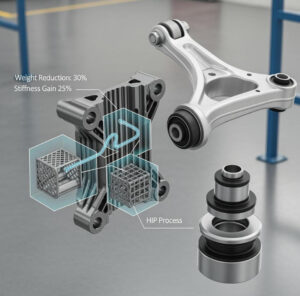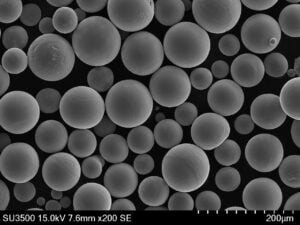3D Printing Custom Fluid Manifolds
Table of Contents
Introduction
The landscape of industrial manufacturing is constantly evolving, driven by the need for greater efficiency, customization, and performance. Within this dynamic environment, fluid manifolds play a critical role across a multitude of sectors, from directing hydraulic power in aerospace systems to controlling coolant flow in automotive engines and managing intricate liquid pathways in medical devices. Traditionally manufactured through subtractive methods like machining, creating complex internal geometries and highly customized designs in fluid manifolds has often been a time-consuming and resource-intensive process, presenting limitations in design freedom and overall system optimization.
However, the advent of metal 3D printing, also known as metal additive manufacturing, has ushered in a paradigm shift in how these critical components are conceived and produced. This innovative technology empowers engineers and procurement managers to overcome the constraints of conventional manufacturing, enabling the creation of custom fluid manifolds with intricate internal channels, optimized flow paths, and consolidated designs. By building parts layer by layer from metal powders, metal 3D printing unlocks unprecedented design flexibility, allowing for the integration of features that were previously impossible or prohibitively expensive to achieve. This capability is particularly significant for industries like aerospace, automotive, medical, and industrial manufacturing, where the demand for high-performance, application-specific fluid management solutions is continually growing. As businesses strive for lighter, more efficient, and more reliable systems, the ability to rapidly prototype and produce custom fluid manifolds with tailored functionalities through metal 3D printing is becoming an indispensable advantage. At Metal3DP, we understand this evolving need and are at the forefront of providing advanced metal additive manufacturing solutions to meet these demanding requirements.
What are Custom Fluid Manifolds Used For?
Custom fluid manifolds are integral components in a vast array of industrial applications, serving as central hubs for controlling the flow of liquids or gases within complex systems. Their primary function is to efficiently distribute hydraulic fluid, coolant, lubricants, or other critical fluids to various points in a machine or system, ensuring optimal performance and operational reliability. The ability to customize the internal channel design, port locations, and overall geometry of these manifolds makes them indispensable for meeting the specific needs of diverse industries:
- Aerospace: In the aerospace sector, custom fluid manifolds are crucial for hydraulic systems that control flight surfaces, landing gear, and braking mechanisms. Their lightweight and complex internal designs, achievable through metal 3D printing, contribute to fuel efficiency and overall aircraft performance. These manifolds often handle high pressures and extreme temperature variations, demanding materials with exceptional strength and durability, such as those offered by Metal3DP’s high-performance metal powders.
- Automotive: Within the automotive industry, custom fluid manifolds play a vital role in engine cooling systems, braking systems, and hydraulic power steering. The ability to create manifolds with optimized flow paths through metal 3D printing enhances the efficiency and performance of these critical systems. Furthermore, the rapid prototyping capabilities of additive manufacturing accelerate the development and testing of new automotive designs.
- Medical Devices: In the medical field, custom fluid manifolds are essential in various applications, including surgical instruments, diagnostic equipment, and drug delivery systems. The intricate and often miniaturized designs required for these applications benefit significantly from the precision and design freedom offered by metal 3D printing. Biocompatible materials, like certain stainless steels available from Metal3DP, are often necessary to meet the stringent requirements of medical devices.
- Industrial Machinery: Across a broad spectrum of industrial machinery, custom fluid manifolds are used in hydraulic power units, lubrication systems, and thermal management systems. The ability to tailor the manifold design to the specific requirements of the machinery optimizes performance, reduces the number of connections, and minimizes potential leak points. Metal 3D printing allows for the creation of robust manifolds capable of withstanding harsh industrial environments.
Beyond these key sectors, custom fluid manifolds find applications in energy production, chemical processing, and many other industries where precise fluid control is paramount. The adaptability and design versatility offered by metal 3D printing make it an increasingly preferred manufacturing method for producing these critical components, allowing for system optimization, reduced assembly complexity, and improved overall performance.
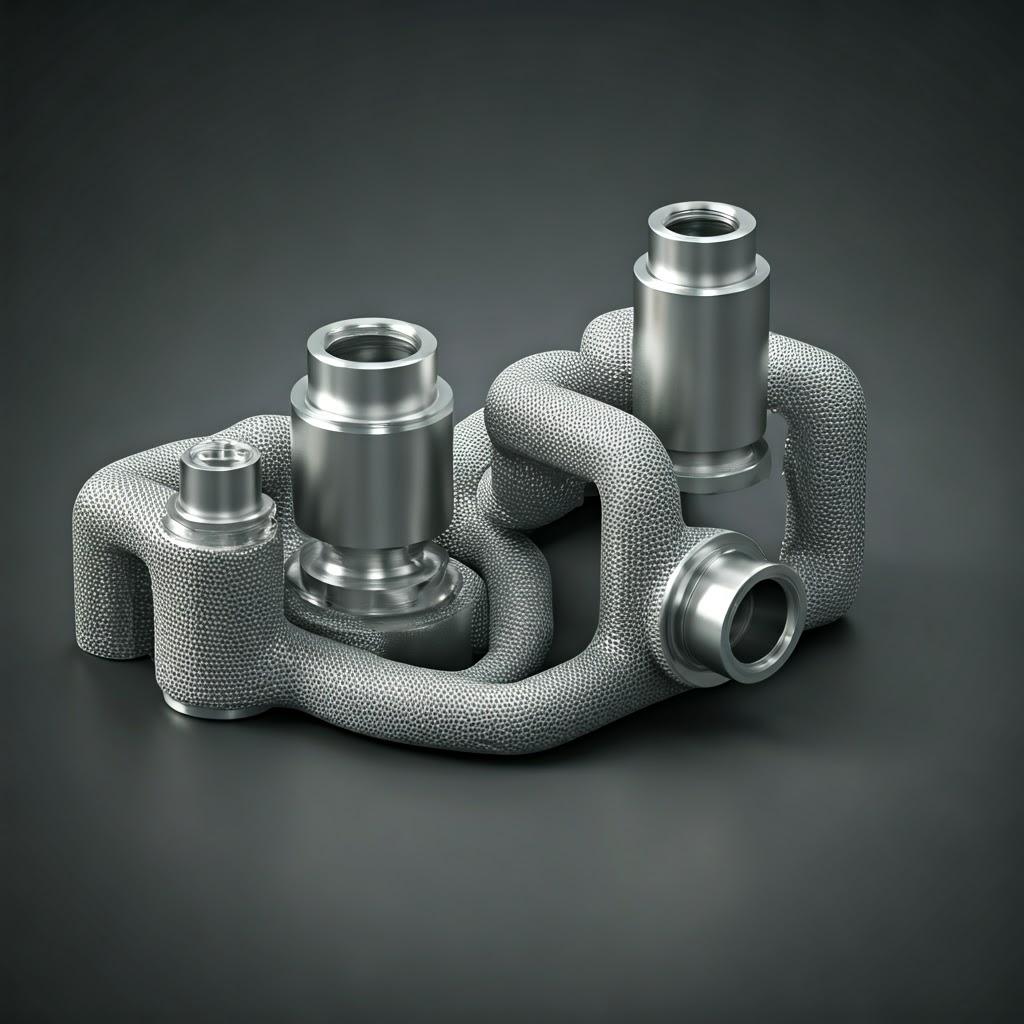
Why Use Metal 3D Printing for Custom Fluid Manifolds?
Opting for metal 3D printing to produce custom fluid manifolds offers a compelling array of advantages over traditional manufacturing methods, particularly when dealing with complex geometries and demanding performance requirements. These benefits are increasingly recognized by engineers and procurement managers across various industries:
- Enhanced Design Freedom and Complexity: Metal 3D printing liberates designers from the constraints of traditional subtractive manufacturing. Intricate internal channels, complex flow paths, and organic shapes that would be difficult or impossible to machine can be readily created. This design freedom allows for optimized fluid dynamics, reduced pressure drops, and more compact manifold designs, leading to improved system efficiency and performance. Metal3DP’s printing methods are specifically designed to handle such complex geometries with high accuracy.
- Part Consolidation and Reduced Assembly: Complex fluid systems often require multiple interconnected components, leading to increased assembly time, potential leak points, and overall system weight. Metal 3D printing enables the consolidation of several parts into a single, integrated manifold. By designing internal channels within a single component, the need for multiple fittings, tubes, and fasteners is significantly reduced, resulting in a more reliable, lighter, and easier-to-manage system.
- Rapid Prototyping and Iteration: The speed and flexibility of metal 3D printing accelerate the design and development cycle. Engineers can quickly iterate on designs, produce functional prototypes, and test their performance with significantly shorter lead times compared to traditional methods. This agility allows for faster optimization and quicker time-to-market for new products and system upgrades.
- Material Efficiency and Waste Reduction: Subtractive manufacturing processes often involve removing a significant amount of material to create the final part, leading to substantial waste. Metal 3D printing, as an additive process, builds parts layer by layer, using only the necessary material. This results in higher material efficiency and reduced waste, contributing to cost savings and more sustainable manufacturing practices.
- Customization and On-Demand Manufacturing: Metal 3D printing is ideally suited for producing highly customized parts in low to medium volumes. Each fluid manifold can be tailored to the specific requirements of an application without the need for expensive tooling or setup changes. This on-demand manufacturing capability also reduces the need for large inventories, leading to further cost savings.
- Improved Performance and Reliability: By optimizing internal flow paths and reducing the number of connections, metal 3D printed fluid manifolds can offer improved hydraulic performance, reduced pressure losses, and minimized potential leak points. The high density and excellent mechanical properties of metal 3D printed parts, especially when using Metal3DP’s advanced metal powders, contribute to the overall reliability and longevity of the fluid system.
In essence, the adoption of metal 3D printing for custom fluid manifolds empowers industries to achieve higher levels of design innovation, system integration, and overall performance, while also offering benefits in terms of speed, cost-effectiveness, and sustainability.
Recommended Materials and Why They Matter
The selection of the appropriate metal powder is paramount in achieving the desired performance characteristics for 3D printed custom fluid manifolds. Metal3DP offers a range of high-quality metal powders optimized for additive manufacturing, and for custom fluid manifolds, two materials stand out for their exceptional properties: AlSi10Mg and IN625.
AlSi10Mg (Aluminum Silicon Magnesium)
AlSi10Mg is a widely used aluminum alloy in metal 3D printing due to its excellent combination of properties, making it highly suitable for various fluid manifold applications:
- Lightweighting: Aluminum alloys are significantly lighter than steel alloys, which is a critical advantage in aerospace and automotive applications where weight reduction translates directly to improved fuel efficiency and performance.
- Good Thermal Conductivity: AlSi10Mg exhibits good thermal conductivity, making it suitable for fluid manifolds that also play a role in heat management, such as cooling systems.
- High Strength-to-Weight Ratio: This alloy offers a good balance of strength and weight, providing the necessary structural integrity for fluid manifolds while minimizing overall system mass.
- Excellent Processability: AlSi10Mg is well-established in laser powder bed fusion (LPBF) processes, offering good printability and the ability to achieve complex geometries with high accuracy.
IN625 (Nickel-Chromium Alloy)
IN625 is a high-performance nickel-based superalloy known for its exceptional properties in demanding environments:
- High Corrosion Resistance: IN625 exhibits outstanding resistance to a wide range of corrosive media, making it ideal for fluid manifolds that handle aggressive fluids or operate in harsh environments, such as marine or chemical processing applications.
- High Strength at Elevated Temperatures: This alloy maintains its high strength and creep resistance at elevated temperatures, making it suitable for fluid manifolds used in high-temperature applications, such as exhaust systems or thermal management in aerospace.
- Excellent Weldability and Fabricability: While typically processed through additive manufacturing, the inherent weldability of IN625 is a testament to its robust metallurgical properties. It also exhibits good fabricability in AM processes, allowing for the creation of intricate designs.
- High Toughness and Fatigue Resistance: IN625 offers excellent toughness and resistance to fatigue, ensuring the long-term reliability of fluid manifolds subjected to pressure cycling and mechanical stresses.
The choice between AlSi10Mg and IN625 depends on the specific requirements of the fluid manifold application. If lightweighting and good thermal conductivity are primary concerns, AlSi10Mg is an excellent choice. For applications demanding high corrosion resistance and high-temperature performance, IN625 provides superior capabilities. Metal3DP’s expertise in metal powders ensures that customers receive materials with consistent quality and optimized properties for their specific needs.

Design Considerations for Additive Manufacturing of Fluid Manifolds
Designing fluid manifolds for metal 3D printing requires a different mindset compared to traditional manufacturing. To fully leverage the capabilities of additive manufacturing and ensure optimal functionality, performance, and cost-effectiveness, engineers should consider the following design principles:
- Internal Channel Design Optimization: One of the primary advantages of metal 3D printing is the ability to create complex internal channels with optimized flow paths. Designers should focus on minimizing sharp corners and abrupt changes in direction to reduce pressure drops and turbulence. Smooth, gradual curves and optimized branching can significantly improve fluid flow efficiency. Computational Fluid Dynamics (CFD) analysis can be invaluable in simulating and refining internal channel designs for optimal performance.
- Minimizing Support Structures: Support structures are often necessary in metal 3D printing to prevent collapse or distortion during the build process, especially for overhanging features and internal channels. However, supports add to material usage, printing time, and post-processing effort. Designing the manifold with self-supporting angles (typically 45 degrees or less) and strategically orienting the part on the build platform can minimize the need for extensive support structures. Consideration should also be given to the ease of support removal in internal channels.
- Wall Thickness and Structural Integrity: While metal 3D printing allows for thin walls and intricate features, ensuring sufficient wall thickness is crucial for the structural integrity of the fluid manifold, especially when operating under high pressures. The minimum wall thickness should be determined based on the material properties, operating pressure, and the overall geometry of the manifold. Finite Element Analysis (FEA) can be used to simulate stress distribution and optimize wall thickness for weight reduction without compromising structural integrity.
- Integrating Features and Functionality: Metal 3D printing enables the integration of multiple functionalities into a single component. Designers should explore opportunities to incorporate features such as mounting points, sensor housings, and even integrated cooling channels directly into the manifold design. This reduces the need for additional parts and assembly steps, leading to a more compact and efficient system.
- Design for Powder Removal: For manifolds with complex internal channels, it’s essential to design features that allow for the effective removal of un-sintered powder after the printing process. This may involve incorporating strategically placed escape holes or designing channels with sufficient diameter to facilitate powder evacuation.
- Surface Finish Considerations: The surface finish achievable with metal 3D printing can vary depending on the material and printing process. For critical sealing surfaces or areas requiring smooth fluid flow, post-processing techniques like machining or polishing may be necessary. Designers should consider the required surface finish early in the design process to plan for appropriate post-processing steps.
- Orientation on the Build Platform: The orientation of the fluid manifold on the build platform can significantly impact the surface finish, support requirements, and dimensional accuracy of the final part. Careful consideration should be given to orienting the part to minimize support volume, improve surface quality on critical features, and ensure dimensional accuracy in key areas.
By thoughtfully addressing these design considerations, engineers can harness the full potential of metal 3D printing to create custom fluid manifolds with optimized performance, reduced weight, and enhanced functionality. Met3DP’s application development services can provide valuable expertise in designing for metal additive manufacturing.
Tolerance, Surface Finish, and Dimensional Accuracy of 3D Printed Manifolds
Achieving the required tolerance, surface finish, and dimensional accuracy is paramount for the functional performance of custom fluid manifolds. Metal 3D printing technologies have advanced significantly, offering increasingly precise and consistent results. However, understanding the capabilities and limitations of the specific printing process and material is crucial:
- Dimensional Accuracy: The dimensional accuracy achievable in metal 3D printing depends on several factors, including the printing technology (e.g., Laser Powder Bed Fusion (LPBF), Electron Beam Melting (EBM)), the material used, the size and complexity of the part, and the build parameters. Typically, tolerances in the range of ±0.1 to ±0.5 mm can be achieved for critical dimensions in LPBF processes. Finer tolerances may be achievable with careful process optimization and post-processing. Metal3DP’s printers are engineered to deliver industry-leading accuracy for mission-critical parts.
- Surface Finish: The surface finish of metal 3D printed parts is generally rougher compared to machined surfaces. The powder particle size and the layer thickness used during printing influence the surface roughness. Typical as-built surface roughness (Ra) values can range from 5 to 20 µm or higher. For fluid manifolds where smooth internal channels are critical for minimizing flow resistance or where external surfaces require a specific finish for sealing or aesthetics, post-processing techniques such as abrasive blasting, polishing, or machining are commonly employed to achieve smoother surfaces.
- Factors Affecting Accuracy and Finish:
- Layer Thickness: Thinner layers generally result in a smoother surface finish and potentially higher accuracy but increase build time.
- Powder Particle Size and Distribution: Finer and more uniform powder particles can contribute to a smoother surface and better resolution. Metal3DP’s advanced powder making system ensures high sphericity and good flowability of its metal powders, which are crucial for achieving consistent print quality.
- Build Orientation: The orientation of the part on the build platform can affect the surface finish of different areas of the part due to the layer-wise building process. Surfaces oriented at shallow angles to the build plane tend to be rougher.
- Support Structures: The attachment points of support structures can leave marks on the surface of the part, requiring post-processing for removal and smoothing.
- Thermal Management During Printing: Controlling the temperature and thermal gradients during the printing process is crucial for minimizing warping and ensuring dimensional accuracy.
- Achieving Tighter Tolerances and Smoother Finishes:
- Design for Manufacturing (DFM): Designing parts with consideration for the limitations and capabilities of the metal 3D printing process can help optimize achievable tolerances and surface finishes.
- Process Optimization: Fine-tuning the printing parameters, such as laser power, scan speed, and layer thickness, can improve accuracy and surface finish.
- Post-Processing: Employing appropriate post-processing techniques like CNC machining, grinding, polishing, or chemical etching can significantly improve the dimensional accuracy and surface finish of 3D printed fluid manifolds to meet demanding specifications.
Understanding the achievable tolerances and surface finishes in metal 3D printing and planning for necessary post-processing steps are essential for producing functional and high-performance custom fluid manifolds.
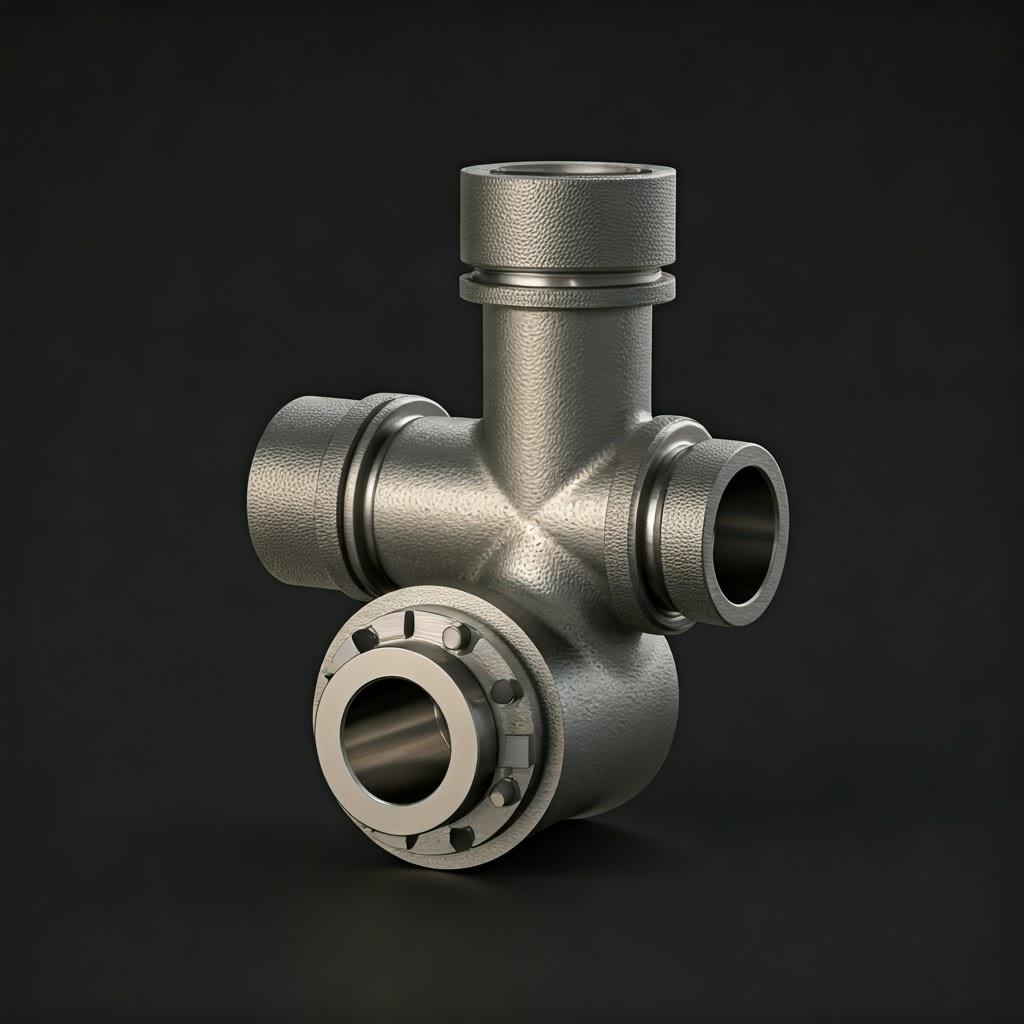
Post-Processing Requirements for Metal 3D Printed Manifolds
While metal 3D printing offers significant advantages in creating complex geometries, post-processing is often a necessary step to achieve the final desired properties, surface finish, and dimensional accuracy of custom fluid manifolds. Common post-processing requirements include:
- Support Removal: Support structures, essential for printing complex geometries, must be removed after the build is complete. The method of support removal depends on the material and the support strategy used. It can involve manual breaking, cutting with specialized tools, or using растворение (dissolution) for certain materials. For internal channels, careful planning during the design phase to minimize internal supports and provide access for removal is crucial.
- Powder Removal: For parts with internal channels and cavities, removing any un-sintered powder trapped within is essential. This can be achieved through methods like blowing with compressed air, vacuuming, or using ultrasonic cleaning baths. Effective powder removal is critical for the proper functioning of fluid manifolds.
- Stress Relief and Heat Treatment: Metal 3D printed parts can have residual stresses due to the rapid heating and cooling cycles during the printing process. Stress relief heat treatment is often performed to reduce these stresses and improve the mechanical properties of the material. Additionally, other heat treatments, such as hardening or annealing, may be required depending on the material and the desired final properties.
- Surface Finishing: As-built metal 3D printed surfaces typically have a certain degree of roughness. Depending on the application requirements, various surface finishing techniques may be employed:
- Abrasive Blasting: Used to remove loose powder, improve surface uniformity, and create a matte finish.
- Polishing: Mechanical or chemical polishing can be used to achieve smoother surfaces, which may be necessary for sealing surfaces or to reduce flow resistance in internal channels.
- Machining (CNC): For critical dimensions and tolerances, CNC machining can be used to achieve high precision and smooth surface finishes on specific features of the manifold, such as mounting surfaces or port connections.
- Leak Testing: For fluid manifolds, ensuring leak-tightness is paramount. After printing and any necessary post-processing, pressure testing is typically performed to verify the integrity of the internal channels and connections.
- Cleaning: Removing any residual powder, processing aids, or contaminants from the surface and internal channels of the manifold is essential before it can be integrated into a system. Various cleaning methods, such as ultrasonic cleaning or solvent rinsing, may be used.
- Coatings and Surface Treatments: Depending on the application environment and the fluid being handled, surface treatments like anodizing, plating, or specialized coatings may be applied to enhance corrosion resistance, wear resistance, or other specific properties.
The specific post-processing steps required for a metal 3D printed fluid manifold depend on the material, the printing process, the design complexity, and the end-use application requirements. Careful planning for post-processing during the design phase can help optimize the overall manufacturing workflow and ensure the final part meets the necessary specifications.
Common Challenges and How to Avoid Them in 3D Printing Manifolds
While metal 3D printing offers numerous advantages for creating custom fluid manifolds, several challenges can arise during the process. Understanding these potential issues and implementing preventative strategies is crucial for successful outcomes:
- Warping and Distortion: Thermal stresses built up during the layer-by-layer printing process can lead to warping or distortion of the part, especially for large or complex geometries.
- How to Avoid: Optimize part orientation on the build platform to minimize stress concentration. Employ build plate heating to reduce thermal gradients. Use appropriate support structures to anchor the part. Consider design modifications to reduce large flat areas.
- Support Structure Removal Difficulties: Removing support structures, especially from intricate internal channels, can be challenging and may damage the part surface.
- How to Avoid: Design parts with self-supporting angles whenever possible. Strategically place and design support structures for easy removal. Consider using dissolvable support materials if available for the chosen metal. Ensure sufficient access for support removal from internal channels.
- Porosity and Density Issues: Inconsistent melting or insufficient laser/electron beam energy can lead to porosity within the printed part, compromising its mechanical strength and potentially causing leaks in fluid manifolds.
- How to Avoid: Optimize printing parameters such as laser power, scan speed, and layer thickness for the specific material and machine. Ensure high-quality metal powder with good flowability and packing density, such as those provided by Metal3DP. Employ inert gas atmosphere during printing to minimize oxidation.
- Internal Channel Blockage: Un-sintered powder can become trapped in narrow or complex internal channels, obstructing fluid flow.
- How to Avoid: Design internal channels with sufficient diameter and strategically placed escape holes for powder removal. Use effective post-processing cleaning methods like high-pressure air or ultrasonic cleaning. Consider design modifications to simplify internal geometries.
- Surface Roughness: As-built metal 3D printed surfaces can be too rough for certain sealing applications or to minimize flow resistance.
- How to Avoid: Optimize printing parameters for better surface finish (e.g., thinner layers). Plan for appropriate post-processing techniques like abrasive blasting, polishing, or machining for critical surfaces.
- Dimensional Inaccuracies: Deviations from the intended dimensions can occur due to factors like shrinkage during solidification or thermal expansion and contraction.
- How to Avoid: Calibrate the 3D printer regularly. Optimize build parameters for the specific material and geometry. Account for potential shrinkage in the design phase. Consider using build platform compensation techniques.
- Material Inhomogeneity: Variations in the microstructure or composition of the printed part can affect its mechanical properties.
- How to Avoid: Use high-quality, consistent metal powders from reputable suppliers like Metal3DP. Optimize printing parameters for uniform melting and solidification. Consider post-processing heat treatments to homogenize the microstructure.
By understanding these common challenges and implementing appropriate design and process optimization strategies, engineers can significantly mitigate these risks and achieve successful metal 3D printing of high-performance custom fluid manifolds.

How to Choose the Right Metal 3D Printing Service Provider for Manifolds
Selecting the appropriate metal 3D printing service provider is crucial for obtaining high-quality custom fluid manifolds that meet your specific requirements and industry standards. Consider the following factors when evaluating potential suppliers:
- Material Expertise and Range: Ensure the service provider has extensive experience processing the recommended materials (AlSi10Mg and IN625) and offers a range of other high-performance metal alloys relevant to your industry. A provider with a deep understanding of material properties and their behavior in additive manufacturing, like Metal3DP, will be able to optimize the printing process for your specific application.
- Printing Technology and Capabilities: Different metal 3D printing technologies (e.g., LPBF, DED, Binder Jetting) offer varying levels of precision, surface finish, and build volume. Choose a provider whose technology aligns with the complexity, size, and performance requirements of your fluid manifolds. Inquire about their equipment specifications, including build volume, layer thickness capabilities, and in-process monitoring systems.
- Quality Assurance and Certifications: Verify that the service provider has robust quality control procedures in place, including material traceability, in-process inspection, and post-process verification. Relevant certifications, such as ISO 9001 or industry-specific standards (e.g., AS9100 for aerospace, ISO 13485 for medical devices), indicate a commitment to quality and reliability.
- Design for Additive Manufacturing (DfAM) Support: A knowledgeable service provider should offer expertise in DfAM principles to help optimize your fluid manifold design for metal 3D printing. This includes guidance on topology optimization, internal channel design, support structure minimization, and material selection to enhance performance and reduce costs. Metal3DP’s application development services can assist with these critical design considerations.
- Post-Processing Services: Determine if the provider offers the necessary post-processing services to meet your specifications, such as support removal, powder removal, heat treatment, surface finishing (e.g., polishing, machining), and leak testing. An in-house or well-established network of post-processing capabilities can streamline the manufacturing process and ensure quality control.
- Industry Experience and Case Studies: Look for a service provider with a proven track record of producing fluid manifolds or similar components for your industry. Review case studies and testimonials to assess their experience and the quality of their work. Experience in demanding sectors like aerospace, automotive, and medical devices often indicates a high level of technical competence.
- Communication and Customer Support: Effective communication and responsive customer support are essential for a smooth and successful project. Evaluate the provider’s responsiveness to inquiries, their willingness to collaborate on design and material selection, and their ability to provide regular updates on project progress.
- Lead Times and Production Capacity: Understand the provider’s typical lead times for similar projects and their production capacity to ensure they can meet your delivery requirements, especially for larger volumes or recurring orders.
- Cost Structure and Transparency: Request a detailed cost breakdown that includes printing costs, material costs, design optimization fees (if applicable), post-processing charges, and shipping. Ensure transparency in their pricing structure and inquire about potential cost-saving strategies through design modifications or material alternatives.
By carefully evaluating these factors, you can select a metal 3D printing service provider that aligns with your technical requirements, quality standards, budget, and timeline, ultimately ensuring the successful production of your custom fluid manifolds.
Cost Factors and Lead Time for 3D Printed Custom Fluid Manifolds
The cost and lead time associated with metal 3D printing custom fluid manifolds are influenced by a variety of factors. Understanding these elements is crucial for budgeting and project planning:
Cost Factors:
- Material Costs: The cost of the metal powder is a significant factor. Alloys like IN625 are typically more expensive than materials like AlSi10Mg. The quantity of material required for the part, which is influenced by its size and density, directly impacts the material cost. Optimizing the design to reduce material usage through techniques like hollow structures or lattice infills can help mitigate this cost. Metal3DP offers a range of high-quality metal powders at competitive prices.
- Build Time: The time it takes to print a fluid manifold is a key driver of cost. Longer build times consume more machine time and energy. Factors affecting build time include the part’s volume, complexity, layer thickness, and the number of parts that can be nested on a single build platform. Design optimization to minimize build volume and efficient part orientation can help reduce printing time.
- Pre-Processing and Design Optimization: If design optimization for additive manufacturing is required, including topology optimization or detailed internal channel design, there may be associated engineering costs. Similarly, preparing the 3D model for printing, such as generating support structures and defining build parameters, involves pre-processing time and potential costs.
- Post-Processing Costs: The extent of post-processing required significantly impacts the overall cost. Simple support removal and cleaning will have a lower cost than more complex processes like extensive machining, polishing, heat treatment, or specialized coatings. Planning for minimal post-processing through design and material selection can help control these costs.
- Machine and Operational Costs: Service providers factor in the cost of operating and maintaining their metal 3D printing equipment, including depreciation, energy consumption, and labor. These overhead costs are typically reflected in the printing price.
- Quantity and Volume: The cost per part generally decreases with higher production volumes due to economies of scale. However, metal 3D printing is often most cost-effective for low to medium volumes and highly customized parts where traditional tooling costs would be prohibitive.
Lead Time:
- Design and Engineering: The initial design phase, including any necessary simulations and optimizations, can take varying amounts of time depending on the complexity of the fluid manifold and the need for iterations.
- Pre-Processing and Build Preparation: Preparing the 3D model for printing, including orientation optimization, support generation, and build file creation, adds to the lead time.
- Printing Time: The actual printing duration is determined by the part’s size, complexity, and the chosen printing technology. This can range from a few hours to several days.
- Post-Processing: The time required for post-processing steps like support removal, powder removal, heat treatment, and surface finishing can vary significantly depending on the complexity and the specific techniques employed.
- Quality Control and Inspection: Thorough quality checks and dimensional inspections add to the overall lead time but are essential to ensure the part meets the required specifications.
- Shipping and Delivery: The final lead time includes the time for packaging and shipping the completed fluid manifolds to the customer.
It’s important to discuss both cost and lead time expectations with potential metal 3D printing service providers early in the project. Obtaining detailed quotes and understanding the factors that influence these parameters will enable informed decision-making and realistic project timelines.

Frequently Asked Questions (FAQ)
- What are the typical tolerances achievable with metal 3D printed fluid manifolds?
- Typical tolerances for critical dimensions achieved through Laser Powder Bed Fusion (LPBF) range from ±0.1 mm to ±0.5 mm. Finer tolerances can be achieved with optimized processes and post-processing techniques like CNC machining. Metal3DP’s printers are designed for high accuracy.
- Can metal 3D printed fluid manifolds withstand high pressures?
- Yes, metal 3D printed parts, especially when produced from high-strength alloys like IN625 using dense printing parameters, can withstand significant pressures. The pressure rating depends on the material, wall thickness, and the overall design of the manifold. Finite Element Analysis (FEA) is often used to validate the pressure-bearing capabilities.
- What is the typical surface finish of an as-built metal 3D printed fluid manifold, and can it be improved?
- The as-built surface roughness (Ra) typically ranges from 5 to 20 µm or higher, depending on the printing process and material. This can be improved through various post-processing methods such as abrasive blasting, polishing, and machining to meet specific requirements for sealing or fluid flow.
- Are there any limitations to the complexity of internal channels that can be created in 3D printed fluid manifolds?
- Metal 3D printing offers significant design freedom for internal channels compared to traditional methods. However, very small or intricate channels may pose challenges for powder removal. Designing channels with sufficient diameter and incorporating escape holes can mitigate this. Consulting with a DfAM expert, like those at Metal3DP, is recommended for highly complex designs.
- What considerations are important for ensuring the leak-tightness of 3D printed fluid manifolds?
- Achieving leak-tightness requires dense printing with minimal porosity. Optimizing printing parameters, using high-quality metal powders, and appropriate post-processing, including thorough powder removal and potentially surface sealing treatments, are crucial. Pressure testing is a standard procedure to verify leak-tightness.
Conclusion
Metal 3D printing stands as a transformative technology for the design and manufacture of custom fluid manifolds, offering unparalleled design freedom, part consolidation opportunities, and the ability to tailor material properties to specific application demands. Industries such as aerospace, automotive, medical, and industrial manufacturing are increasingly leveraging the advantages of additive manufacturing to create high-performance, efficient, and reliable fluid management solutions.
By utilizing advanced metal powders like AlSi10Mg and IN625, and partnering with experienced providers like Metal3DP, engineers and procurement managers can overcome the limitations of traditional manufacturing, achieving intricate internal geometries, optimized flow paths, and reduced assembly complexity. While careful consideration of design for additive manufacturing principles, tolerance and surface finish requirements, and post-processing needs is essential, the benefits of metal 3D printing – including rapid prototyping, material efficiency, and on-demand customization – make it an increasingly compelling choice for producing next-generation fluid manifolds. Embracing metal additive manufacturing empowers organizations to innovate faster, improve product performance, and ultimately gain a competitive edge in their respective industries. Contact Metal3DP today to explore how our comprehensive metal AM solutions can power your organization’s additive manufacturing goals.
Share On
MET3DP Technology Co., LTD is a leading provider of additive manufacturing solutions headquartered in Qingdao, China. Our company specializes in 3D printing equipment and high-performance metal powders for industrial applications.
Inquiry to get best price and customized Solution for your business!
Related Articles
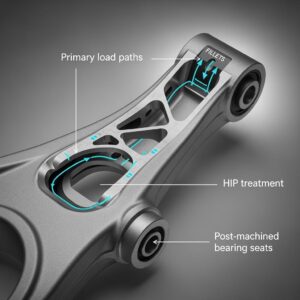
Metal 3D Printing for U.S. Automotive Lightweight Structural Brackets and Suspension Components
Read More »About Met3DP
Recent Update
Our Product
CONTACT US
Any questions? Send us message now! We’ll serve your request with a whole team after receiving your message.







